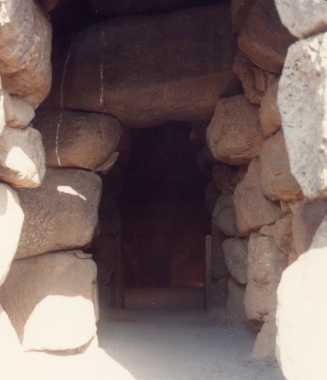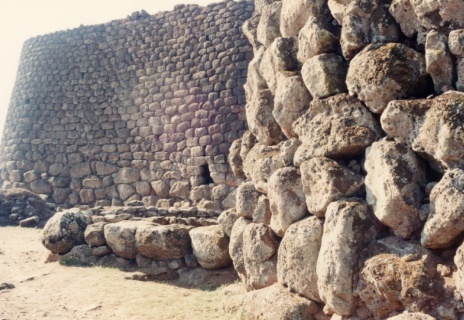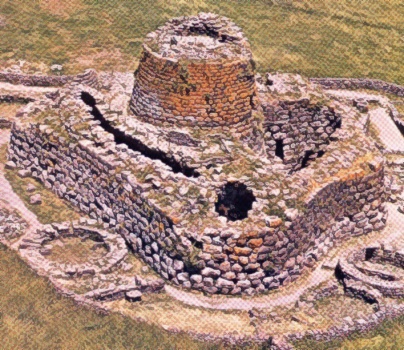The astronomical bearing of Nuraghi
Towers or center towers. Line of departure for a formulation of any credible hypotheses, this is another table elaborated by the writer with the deducing data of: Lilliu, La civiltà nuragica, Sassari 1982.
Astral correspondences of the alignments
of the openings of the nuragic towers or the complex nuraghi central towers
|
Name |
Site |
Bearing |
Azimut |
Age |
Astral alignments |
1 |
Palmavera |
Alghero (SS) |
E |
75 |
Bronze Age |
? |
2 |
Nuraddéo |
Suni (NU) |
E |
82 |
Bronze Age |
? |
3 |
Marosini |
Tertenia (NU) |
E |
87 |
Bronze Age |
? |
4 |
Muru de sa Figu |
Santulussurgiu (OR) |
E |
110 |
Bronze Age |
? |
5 |
Su Igante |
Uri (SS) |
SE |
115 |
Bronze Age |
? |
6 |
Genna Masoni |
Gàiro (NU) |
SE |
122 |
Bronze Age |
Winter solstice sunrise |
7 |
Attentu |
Ploaghe (SS) |
SE |
123 |
Bronze Age |
Winter solstice sunrise |
8 |
Krasta |
Santulussurgiu (OR) |
SE |
128 |
Bronze Age |
? |
9 |
Giba e Scorka |
Barisardo (NU) |
SE |
130 |
Bronze Age |
? |
10 |
Molineddu |
Séneghe (OR) |
SE |
133 |
Bronze Age |
? |
11 |
Frida |
Illorài (SS) |
SE |
135 |
Bronze Age |
Greater southern lunar solstice sunrise |
12 |
Madrone o Frolìo |
Silanus (NU) |
SE |
135 |
Bronze Age |
Greater southern lunar solstice sunrise |
13 |
Murarti |
Silanus (NU) |
SE |
135 |
Bronze Age |
Greater southern lunar solstice sunrise |
14 |
Tittirriola |
Bolòtana (NU) |
SE |
136 |
Bronze Age |
? |
15 |
Lugherras |
Paulilàtino (OR) |
SE |
137 |
Bronze Age |
? |
16 |
Sa Mura e Màzzala |
(NU) |
SE |
138 |
Bronze Age |
? |
17 |
Nàrgius |
Bonàrcado (OR) |
SE |
140 |
Bronze Age |
? |
18 |
Orrùbiu |
Arzana (NU) |
SE |
140 |
Bronze Age |
? |
19 |
Porkarzos |
Bòrore (NU) |
SE |
143 |
Bronze Age |
? |
20 |
Su Konkali |
Tertenìa (NU) |
SE |
144 |
Bronze Age |
? |
21 |
S. Sofia |
Gùspini (CA) |
SE |
144 |
Bronze Age |
? |
22 |
Bronku |
Bonàrcado (OR) |
SE |
145 |
Bronze Age |
? |
23 |
Sa Figu Rànchida |
Scanu Montiferru (NU) |
SE |
145 |
Bronze Age |
? |
24 |
Logomake |
Fonni (NU) |
SE |
148 |
Bronze Age |
? |
25 |
S. Barbara |
Macomèr (NU) |
SE |
148 |
Bronze Age |
? |
26 |
Pùliga |
Locéri (NU) |
SE |
151 |
Bronze Age |
Alfa Centauri on 1100 b.C. and/or Alfa crucis on 1350 |
27 |
Pranu Nuracci |
Siris (CA) |
SE |
155 |
Bronze Age |
? |
28 |
Mindeddu |
Barisardo (NU) |
S |
165 |
Bronze Age |
? |
29 |
S. Sarbana |
Silanus (NU) |
S |
165 |
Bronze Age |
? |
30 |
Sa Corona |
Villagreca (CA) |
S |
164 |
Bronze Age |
? |
31 |
S’ Ome ‘e s’Orku |
S.Basilio (CA) |
S |
166 |
Bronze Age |
? |
32 |
Losa |
Abbasanta (OR) |
S |
169 |
Bronze Age |
? |
33 |
Piandanna |
Sassari |
S |
170 |
Bronze Age |
? |
34 |
Sa Domo ‘e s’Orku |
Ittireddu (SS) |
S |
171 |
Bronze Age |
? |
35 |
Cabu Abbas |
Olbia (SS) |
S |
171 |
Bronze Age |
? |
36 |
Baiolu |
Osilo (SS) |
S |
172 |
Bronze Age |
? |
37 |
Longu |
Cùglieri (NU) |
S |
172 |
Bronze Age |
? |
38 |
Is Paras |
Isili (NU) |
S |
174 |
Bronze Age |
? |
39 |
Santu Antine |
Torralba (SS) |
S |
174 |
Bronze Age |
? |
40 |
Sa Pedra Longa |
Nuoro |
S |
175 |
Bronze Age |
? |
41 |
Còa Perdona |
Séneghe (OR) |
S |
176 |
Bronze Age |
? |
42 |
Asoru |
San Vito (CA) |
S |
178 |
Bronze Age |
? |
43 |
S’Attentu |
Orani (NU) |
S |
178 |
Bronze Age |
? |
44 |
Su Nuraxi |
Sisini (CA) |
S |
180 |
Bronze Age |
Noon at the equinoxes |
45 |
Su Fràile |
Burgos (SS) |
S |
180 |
Bronze Age |
Noon at the equinoxes |
46 |
Giannas |
Flussìo (NU) |
S |
180 |
Bronze Age |
Noon at the equinoxes |
47 |
Abbaùddi |
Scanu Montiferru (NU) |
S |
180 |
Bronze Age |
Noon at the equinoxes |
48 |
Su Nuraxi |
Barùmini (CA) |
S |
180 |
1660/1260 |
Noon at the equinoxes |
49 |
Noddùle |
Nuoro (NU) |
S |
180 |
Bronze Age |
Noon at the equinoxes |
50 |
Sa Cuguttada |
Mores (SS) |
S |
182 |
Bronze Age |
? |
51 |
Sa Serra |
Orròli (NU) |
S |
182 |
Bronze Age |
? |
52 |
Mont’e s’Orku Tuèri |
Perdasdefogu (NU) |
S |
183 |
Bronze Age |
? |
53 |
Sa Còa Filigosa |
Bolòtana (NU) |
S |
183 |
Bronze Age |
? |
54 |
Su Sensu |
Pompu (CA) |
S |
185 |
Bronze Age |
? |
55 |
Orrùbiu |
Orròli (NU) |
S |
185 |
1400/1340 |
? |
56 |
Nuracc’e Deu |
Gèsturi (CA) |
SO |
210 |
Bronze Age |
? |
57 |
Mudègu |
Mògoro (OR) |
SO |
218 |
Bronze Age |
? |
58 |
Gurti Aqua |
Nurri (NU) |
SO |
225 |
Bronze Age |
? |
59 |
Nuraddèo |
Suni (NU) |
SO |
243 |
Bronze Age |
? |
60 |
S’Iscala e Pedra |
Seméstene (SS) |
N |
358 |
Bronze Age |
? |
As it is remarking in the table, 87% of the incomes of the towers, or of the central towers of 60 nuraghi considered are comprised in an arc of 75° over the 360° of the horizon; 73% in an arc of single 50°. It is the sky arc mainly exposed in sunlight between the hour of the dawn and little after the noon. The more probable alignments (winter solstice sunset, greater southern lunar solstice sunset, noon at the equinoxes etc.) however, are applicable only to a minority of the taken structures considered; so it would be opportune to deepen the possible correspondences around 173° of azimut, also in this enough frequent case. Independently from astronomical-religious motivations, the incomes could be oriented towards South-South East for lighting system reasons; however such circumstance would refute the classic hypothesis of the defensive function of nuraghi, because the eventual invaders would have had the better vision of the inside of the construction, while the defensors would be find themselves dazzled from the solar light.

Nuraghe Llosa-Entrance to the central tower of the complex nuraghe
Mauro Peppino Zedda, in “I Nuraghi tra archeologia e astronomia”, Cagliari 2004, refutes the classic defensive hypothesis, sensationally demonstrating that no nuragic construction was supply of closing device; consequently, in onslaught case, the defenders would have been totally exposed. At the light of the replies of the studious, we dare to propose a new hypothesis about the function of nuragic constructions, in the within of the astronomical-religious thesis.
As Lilliu supports, in the age between neolithic and the bronze age, not only on the Island, but in all Mediterranean, they were the two predominant religious Entities for the prehistoric man: the land element of the feminine goddess mother, and the male solar fertilizing element. No other structure, if not the inside of dark and unfathomable nuragic dome, compressed from titanic walls that shield, but in the same time dominate with their force its eventual host; communicating with the light of the outside, apparently unknown, through an only mysterious opening, it gives the idea of the maternal uterus and bring us back to dark pre-born feelings. The bearing of a similar construction towards the male element of the solar beam, and the penetration of this last one, in astronomical particular given, the dark cavity of the great maternal uterus of the nuragic dome - it seems at the writer - could not representing but the fecundation of the nature and the renew of the myth of the creation, by means of the union of the two male and feminine divine Entities. The nuraghi were the great prehistoric cathedrals where, periodically, it was celebrated what it was representing the greatest and the most religious mystery, at the eyes of the ancient Sardinian man.

Nuraghe Llosa-Note the convexity of the connecting wall
The peripheral towers of the complex nuraghi
All nuraghi are not constituted from one single tower. In the more imposing cases, around the center towers, they have been realized two or more smaller towers, called peripheral towers, apparently to defensive scope. After a series of measurements, carried out beginning from 1995, Peppino Zedda has clamorously refuted also the defensive function of the peripheral towers of the complex nuraghi, discovering the astronomical bearing of the tangent lines of the same towers. According to Zedda, the walls of connection between the peripheral towers of complex nuraghi, were purposely realized with a convex development, in order to favor the astronomical observation of such tangent lines, from observatories setting with the shoulders to the massive walls.
Astral correspondences of the alignments
of the tangent lines to the peripheral towers of the complex nuraghi:
Name |
Site |
Age |
Tangent |
Astral alignments |
Losa |
Abbasanta (OR) |
Bronze Age |
North Tower – South East Tower |
Summer solstice sunset-Winter solstice sunrise |
Losa |
Abbasanta (OR) |
Bronze Age |
South East Tower - South West Tower |
Summer solstice sunrise-Winter solstice sunset |
Nolza |
Meana Sardo (CA) |
Bronze Age |
South East Tower –North West Tower |
Winter solstice sunrise - Summer solstice sunset |
Su Nuraxi |
Barùmini (CA) |
Bronze Age |
North Tower –West Tower |
Southern greather lunar solstice sunset |
Su Nuraxi |
Barùmini (CA) |
Bronze Age |
East Tower-South Tower |
Southern greather lunar solstice sunset |
Santu Antine |
Torralba (SS) |
Bronze Age |
North Tower - East Tower |
Winter solstice sunrise |
Santu Antine |
Torralba (SS) |
Bronze Age |
East Tower –So called principal guard side |
Southern greather lunar solstice sunset |
Zedda has moreover uncovered that an observer placed at the North Tower of Nuraghe Santu Antine can see the solstice winter sunrise behind the East Tower, while arranging on the South Tower, he can characterize the summer solstice sunrise behind the East Tower. Moreover from the East Tower the sunset can be seen behind the North Tower towards summer solstice and behind the South Tower to that winter one. Such characteristics, according to Peppino Zedda, make of the Santu Antine “the dry realized technically more sophisticated constructive apparatus, than the all Earth surface”.

Santu Antine-Note the convexity of the connecting walls




